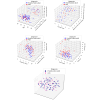Building a Human Digital Twin (HDTwin) Using Large Language Models for Cognitive Diagnosis: Algorithm Development and Validation
- PMID: 39715540
- PMCID: PMC11704625
- DOI: 10.2196/63866
Building a Human Digital Twin (HDTwin) Using Large Language Models for Cognitive Diagnosis: Algorithm Development and Validation
Abstract
Background: Human digital twins have the potential to change the practice of personalizing cognitive health diagnosis because these systems can integrate multiple sources of health information and influence into a unified model. Cognitive health is multifaceted, yet researchers and clinical professionals struggle to align diverse sources of information into a single model.
Objective: This study aims to introduce a method called HDTwin, for unifying heterogeneous data using large language models. HDTwin is designed to predict cognitive diagnoses and offer explanations for its inferences.
Methods: HDTwin integrates cognitive health data from multiple sources, including demographic, behavioral, ecological momentary assessment, n-back test, speech, and baseline experimenter testing session markers. Data are converted into text prompts for a large language model. The system then combines these inputs with relevant external knowledge from scientific literature to construct a predictive model. The model's performance is validated using data from 3 studies involving 124 participants, comparing its diagnostic accuracy with baseline machine learning classifiers.
Results: HDTwin achieves a peak accuracy of 0.81 based on the automated selection of markers, significantly outperforming baseline classifiers. On average, HDTwin yielded accuracy=0.77, precision=0.88, recall=0.63, and Matthews correlation coefficient=0.57. In comparison, the baseline classifiers yielded average accuracy=0.65, precision=0.86, recall=0.35, and Matthews correlation coefficient=0.36. The experiments also reveal that HDTwin yields superior predictive accuracy when information sources are fused compared to single sources. HDTwin's chatbot interface provides interactive dialogues, aiding in diagnosis interpretation and allowing further exploration of patient data.
Conclusions: HDTwin integrates diverse cognitive health data, enhancing the accuracy and explainability of cognitive diagnoses. This approach outperforms traditional models and provides an interface for navigating patient information. The approach shows promise for improving early detection and intervention strategies in cognitive health.
Keywords: artificial intelligence; chatbot; cognitive diagnosis; cognitive health; digital behavior marker; digital twin; health information; human digital twin; interview marker; large language models; machine learning; smartwatch.
©Gina Sprint, Maureen Schmitter-Edgecombe, Diane Cook. Originally published in JMIR Formative Research (https://formative.jmir.org), 23.12.2024.
Conflict of interest statement
Conflicts of Interest: None declared.
Figures




Similar articles
-
A Machine Learning Approach with Human-AI Collaboration for Automated Classification of Patient Safety Event Reports: Algorithm Development and Validation Study.JMIR Hum Factors. 2024 Jan 25;11:e53378. doi: 10.2196/53378. JMIR Hum Factors. 2024. PMID: 38271086 Free PMC article.
-
Noninvasive Oral Hyperspectral Imaging-Driven Digital Diagnosis of Heart Failure With Preserved Ejection Fraction: Model Development and Validation Study.J Med Internet Res. 2025 Jan 7;27:e67256. doi: 10.2196/67256. J Med Internet Res. 2025. PMID: 39773415 Free PMC article.
-
Usability Comparison Among Healthy Participants of an Anthropomorphic Digital Human and a Text-Based Chatbot as a Responder to Questions on Mental Health: Randomized Controlled Trial.JMIR Hum Factors. 2024 Apr 29;11:e54581. doi: 10.2196/54581. JMIR Hum Factors. 2024. PMID: 38683664 Free PMC article. Clinical Trial.
-
Extraction of Substance Use Information From Clinical Notes: Generative Pretrained Transformer-Based Investigation.JMIR Med Inform. 2024 Aug 19;12:e56243. doi: 10.2196/56243. JMIR Med Inform. 2024. PMID: 39037700 Free PMC article.
-
COVID-19 diagnosis: A comprehensive review of pre-trained deep learning models based on feature extraction algorithm.Results Eng. 2023 Jun;18:101020. doi: 10.1016/j.rineng.2023.101020. Epub 2023 Mar 16. Results Eng. 2023. PMID: 36945336 Free PMC article. Review.
Cited by
-
Digital Twins for Personalized Medicine Require Epidemiological Data and Mathematical Modeling: Viewpoint.J Med Internet Res. 2025 Aug 5;27:e72411. doi: 10.2196/72411. J Med Internet Res. 2025. PMID: 40762974 Free PMC article.
References
-
- O'Malley RPD, Mirheidari B, Harkness K, Reuber M, Venneri A, Walker T, Christensen H, Blackburn D. Fully automated cognitive screening tool based on assessment of speech and language. J Neurol Neurosurg Psychiatry. 2020;92(1):12–15. doi: 10.1136/jnnp-2019-322517. https://eprints.whiterose.ac.uk/169297/ jnnp-2019-322517 - DOI - PubMed
-
- Sand Aronsson FS, Kuhlmann M, Jelic V, Östberg P. Is cognitive impairment associated with reduced syntactic complexity in writing? Evidence from automated text analysis. Aphasiology. 2020;35(7):900–913. doi: 10.1080/02687038.2020.1742282. - DOI
-
- Nicosia J, Aschenbrenner AJ, Balota DA, Sliwinski MJ, Tahan M, Adams S, Stout SS, Wilks H, Gordon BA, Benzinger TLS. Unsupervised high-frequency smartphone-based cognitive assessments are reliable, valid, and feasible in older adults at risk for Alzheimer's disease. J Int Neuropsychol Soc. 2023;29(5):459–471. doi: 10.31234/osf.io/wtsyn. - DOI - PMC - PubMed
-
- Schmitter-Edgecombe M, Luna C, Beech B, Dai S, Cook D. Capturing cognitive capacity in the everyday environment across a continuum of cognitive decline using a smartwatch n-back task and ecological momentary assessment. Neuropsychology. 2024 doi: 10.1037/neu0000984.2025-46915-001 - DOI - PMC - PubMed
-
- Cook D, Walker A, Minor B. A cross-study analysis of mobile EMA in monitoring behavior and well-being: insights to refine EMA methods. JMIR mHealth uHealth. 2024 doi: 10.2196/preprints.57018. https://www.researchgate.net/publication/378414238_A_Cross-Study_Analysi... - DOI
MeSH terms
Grants and funding
LinkOut - more resources
Full Text Sources

